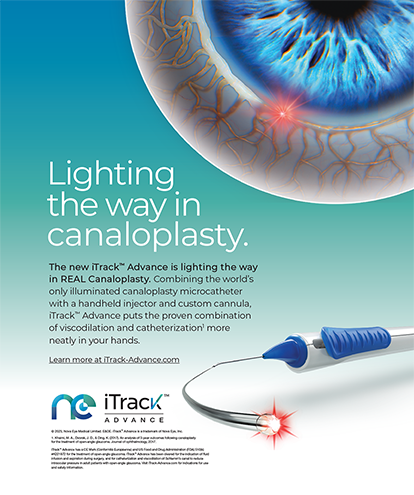Recent advances in dry eye diagnostic and treatment modalities are allowing physicians to better understand, anticipate, and meet the needs of a significant portion of our refractive surgery patients. Four years ago, like most of my colleagues, I would perform Schirmer's testing and inform patients of a pre-existing dry eye condition only if they reported a history of dry eyes, or if they had significant corneal staining. Although the postoperative dry eye was mild and of little consequence in most cases, occasionally patients would voice their displeasure with this condition that they felt did not exist prior to surgery, but became quite bothersome after surgery. I began tracking the extra office visits that were due to patient complaints related to this condition.
Impressive Results
As a cornea specialist, I had already discovered that, in my most severe Sjögrens patients, TheraTears (Advanced Vision Research, Woburn, MA) significantly improved their comfort, corneal appearance, and tear production—so much so that I often cancelled planned punctal occlusion procedures.
Additional Research
At that time, I decided to treat all refractive surgery patients with a 2- to 4-week regimen of TheraTears (Figure 1) to boost tear production prior to their procedure. I immediately noticed a threefold decline in additional dry eye-related, postsurgical office visits. I presented these findings at the 1999 ISRS Summer Symposium.
In January 2001, after hearing a presentation by Vance Thompson, MD, on utilizing the Touch Scientific, Inc. (Raleigh, NC) Tear Assay Test in all LASIK patients to detect aqueous deficient dry eye, I was surprised to learn that approximately 40% of his patients, when given the LASIK screening exam, had low tear lactoferrin levels, consistent with aqueous deficient dry eyes. Dr. Thompson found that these patients were more prone to having dry eye problems and undercorrections after surgery until he started treating them with silicone lacrimal plugs before their surgery.
I obtained a broad checklist from Lacrimedics (Eastsound, WA) of dry eye symptoms, and began requiring all refractive surgery candidates to fill out this sheet, and undergo Schirmer's testing as well as Tear Assay Testing on occasion. Corroborating Dr. Thompson's findings, we found that 40 to 50% of our patients had a mild-to-moderate, pre-existing dry eye condition prior to surgery. Once we identified this condition, explained it to the patients as it related to their self-reported symptoms on our symptom checklist, and correlated these symptoms with their Schirmer's and/or Tear Assay Test results, we found that our patients appreciated the extra time we took to evaluate their eyes. We routinely incorporated a supplemental “Pre-existing Dry Eye Condition” form that these patients would then sign, acknowledging their understanding of this condition. Once we established this new routine, we found patients to be willing partners in preventing and treating any exacerbation of their dry eye condition.
Improving Patient Satisfaction
In addition to pretreating with TheraTears, we supplemented our treatment of mild-to-moderate dry eye patients with collagen lacrimal plugs placed in each lacrimal punctum at the time of surgery. We also advised each of these patients that there was a 10% chance that they could require additional permanent silicone plugs if their dry eye condition worsened after surgery. Again, patients seemed very accepting and understanding of this possibility, once they were diagnosed and advised before surgery. We continue to treat all LASIK and PRK patients with TheraTears for every 2 waking hours for the first month after surgery, continuing thereafter only as needed.
After LASIK, PRK, or even PRELEX surgery with the Array multifocal lens (Allergan Surgical, Inc., Irvine, CA), I find most cases of less-than-satisfactory vision and/or comfort to be due either to undercorrections or dry eye. Correcting undercorrections and aggressively treating dry eye problems early, with TheraTears and then with lacrimal plugs, allows me to maintain a high level of patient satisfaction with both vision and comfort.
In recent years, my practice has become a magnet, not only for those seeking the most qualified, safest approach for laser vision correction, but also for second opinions and management of unsuccessful cases performed elsewhere. Paradoxically, as technology advances, I am seeing still more and more problems that technology alone can't solve. Many patients are unhappy because they don't see clearly and their eyes are uncomfortable. Often, they have already been treated with topical NSAIDS, bandage contact lenses, and even systemic methotrexate! A surprisingly high number of dissatisfied patients treated at other centers have what I consider to be a “subclinical” case of severe dry eyes. Their symptoms, Schirmer's results, and Tear Assay Test results heavily suggest dry eyes, but slit lamp findings of corneal staining may be slight to none. These patients tend to improve after a month of treatment with TheraTears, followed by aggressive use of silicone lacrimal plugs.
Moving Forward
We are now beginning a study to compare the effectiveness of TheraTears versus lacrimal plugs alone versus both, in raising tear lactoferrin levels (a marker for aqueous deficient dry eyes). In the meantime, I find great value in maintaining a high index of suspicion for dry eye before, during, and after performing surgery by communicating my findings to our patients, and proceeding aggressively with treatment options once this condition starts to affect patients after their procedure.


